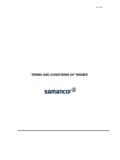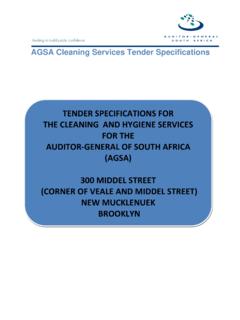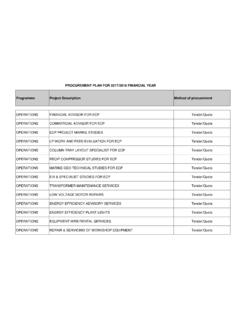Transcription of NTPC Safety Rules - NTPC Tender
1 1 NTPC Safety Rules Issued by : CORPORATE Safety DEPARTMENT, NTPC Ltd., 2 Index Contents Page General 4 Definitions 5 Responsibilities of the contractor 8 Construction Cess 9 Safety Organization 9 Safety Training 9 Reporting of accidents 10 Emergency Action Plan 11 Safety in the workplace 12 Safety in material handling 18 Safety in welding and gas cutting 23 Safety in the use of electricity 26 Safety in the use of hand tools and power operated tools 31 Safety in the use of ladders and stairs 34 Safety in the use of lifting appliances 37 Safety in the use of transport, earthmoving equipment etc 50 Safety in the use of runways and ramps 52 Safety in storage, handling and use of explosives 53 Safety in excavation and tunneling work 61 Safety in piling work 73 3 Safety in erection.
2 Use and dismantling of scaffolds 75 Safety in the construction of structural frame and formwork 79 Safety in concreting work 81 Safety in construction of catch platforms, hoardings 86 Safety in the use of chutes 86 Safety in the work on or adjacent to water 86 Safety in cofferdams & caissons 87 Safety in demolition work 88 Fire Safety provisions 91 Appendix 93 Schedules: 98 4 GENERAL 1. There are mainly two following Acts and Rules (hereinafter referred to as Rules ) that specifically provide for Safety , Health and Welfare Measures, which are specifically applicable for the building and construction workers, namely: Building and other construction workers (regulation of employment and conditions of service) Act, 1996 (briefly referred to as Building & Construction Act), Building and other construction workers (regulation of employment and conditions of service) Central Rules , 1998 (briefly referred to as Building & Construction Rules ) as adopted by the various State Governments, Factories Act, 1948, and State Factories Rules , (briefly referred to as Factories Rules ) as adopted by the various State Governments.
3 2. While these legislations set out the minimum standards of compliance, the Management of the NTPC Ltd. had formulated additional and more stringent norms for the contractors to be referred as NTPC Safety Rules (Also mentioned as Safety Rules for Construction and Erection), wherever felt necessary, for compliance by the Contractors, to whom it shall award contracts for building construction and/ or erection work within their existing Plants or at sites in a green field, or wherever it has control and where new construction and building activities are to be undertaken. 3. Wherever there are contradictions in Statutory Provisions, Technical Specifications or NTPC Safety Rules , the provisions- which are more stringent shall be applicable for compliance by the Contractor.
4 4. Any expansion, modification, alteration and, or construction activity within an existing Plant operating as per approved site plan under the Factories Act, shall attract the provisions of this Act/ Rules also, and the Contractor shall implement all required provisions thereof. For any construction within the premises of NTPC premises covered under the Factories Act, the norms of Building and other construction workers (regulation of employment and conditions of service) Central Act/ Rules , or Factories At/ Rules - which ever are stringent shall be complied by the Contractor. 5. The NTPC Rules primarily highlights a set of Safety requirements derived from both the Building & Construction Act/ Rules and Factories Act/ Rules , Indian Standards- as applicable, and other NTPC requirements.
5 These norms shall be deemed to be the NTPC Safety Rules for Construction and Erection, as mentioned in general conditions of contract. The Contractor shall also implement Permit systems for various activities of Construction and Erection as framed for implementation at local level. 5 6. The Contractor shall indemnify NTPC from all the liabilities that may arise out of any failure to comply with the above mentioned Acts/ Rules or any contravention thereof by the contractor or any other agency on his behalf. 7. It is also mandated that the Engineer-in-charge or NTPC Project Safety Officials, may, on their convenience, exercise such superintendence, supervision and/ or control, as may be deemed necessary, but this shall not absolve the contractor of his basic responsibility for strict compliance with the norms, standards and, or legal provisions as applicable under the Factories Act/ Rules and the Building and other construction (regulation of employment and conditions of service) Act/ Rules .
6 8. The Safety Rules for Construction & Erection, as outlined hereunder, while setting out a broad parameter of Safety norms, are not exhaustive. The Contractor is advised to refer to other statutory provisions, as applicable, for details and strict compliance thereof. 9. The contractor is also required to ensure compliance with provisions of all the Acts/ Rules that provide for Safety measures such as: i. Electricity Act/ Rules ii. Boiler Act/ Rules /Regulations iii. Explosives Act/ Rules iv. Petroleum Act/ Rules v. Motor Vehicles Act/ Rules vi. Dangerous Machines (Regulation) Act vii. Environment (Protection) Act/ Rules viii. Mines Act/ Rules , etc. 6 Definitions 1. Building or other construction work: means the construction, alteration, repairs, maintenance or demolition, of or, in relation to, power plants and its related activities, buildings, streets, roads, railways, tramways, airfields, generation, transmission and distribution of power, water works, oil and gas installations, electric lines, tunnels, bridges, viaducts, pipelines, towers, cooling towers and such other work as may be specified.
7 2. Building worker: means a person who is employed by a contractor or his subcontractor to do any skilled, semi-skilled or manual, supervisory, technical or clerical work for hire or reward, whether the terms of employment be expressed or implied, in connection with any building or other construction work; 3. Establishment: means an establishment who or which employs building workers in any building or other construction work, and includes an establishment belonging to a contractor; 4. Contractor: means a person who undertakes a contract, to produce a given result for any establishment, other than a mere supply of goods or articles of manufacture by the employment of building workers or who supplies building workers for any work of the establishment, and includes a sub-contractor or any other agency engaged on his behalf; 5.
8 Employer: in relation to an establishment, means the owner thereof that is the contractor himself. 6. Competent Person: means a person so approved by the Central Government who belongs to a testing establishment in India possessing adequate qualification, experience and skill for the purpose of testing, examination or annealing and certification of lifting appliances, lifting gears, wire ropes or pressure plant or equipment; 7. Responsible Person: means a person appointed by the employer to be responsible for the performance of specific duty or duties and who has sufficient knowledge and experience and the requisite authority for the proper performance of such duties; 8. Danger: means danger of accident or of injury or danger to health; 9.
9 Hazard: means danger or potential danger; 10. Hazardous substance: means any substance, which due to its explosiveness, inflammability, radioactivity, toxic or corrosive properties and similar hazardous characteristics may Cause injury; or Affect adversely the human system; or Cause loss of life or damage to property or environment; 7 11. Hazardous Process: comprises roof work, steel erection, and work under and over water, demolition and work in confined space; 12. National Standard: means standards as approved by the Bureau of Indian Standards (BIS) and in the absence of such standards, the standards approved by the Central Government for a specific purpose; 13. Lifting Appliance: means a crane, hoist, derrick, winch, jack, pulley block or other equipment used for lifting materials, objects or building workers; 14.
10 Lifting gear: means ropes, chains, hooks, slings and other accessories of a lifting appliance; 15. Safe Operating Practice: Means the practice followed in building and construction activities for the Safety of workers and for safe operation of machinery and equipment used in such activities. Such practices shall conform to all or any of the following: (a) Relevant Standards approved by BIS; (b) National Building Codes; (c) Manufacturer s instruction on safe use of equipment and machinery; (d) Code of practice on Safety in construction industry published by International Labour Organization (ILO). 16. Safe working load: in relation to an article of lifting gear or lifting appliance, means the load which is the maximum load that may be imposed on such article or appliance with Safety in the normal conditions as assessed and certified by a competent person; 17.






